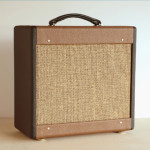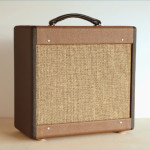Home › Forums › Design and Building › Speaker Talk › Breaking in your speakers
- This topic has 1 reply, 2 voices, and was last updated October 11, 2011 at 6:58 am by
 Robin.
Robin.
-
AuthorPosts
-
September 29, 2011 at 3:47 am #5178
Andy
KeymasterWhat are you guys using to break in your speakers, or are you? I know that Ted Weber had some information up but some of it is no longer available. Here is the post that is still available. My question is, I’ve heard of people using some liquid around the edges. What do you use and how do you apply?
From: Jeff Brinson
I recently purchased a replacement 12″ speaker for my amp. I like its tone, but it seems a little shy on the low end and a little tight overall. Is there anything I can do to loosen it up or improve its tone? I’ve heard of people beating on the magnet and other methods, but I’d like to know what you suggest.Jeff, most speakers are a little tight when new due to the stiffness of the cone surround and spider. After several hours of playing at high levels, they begin to loosen up and have more overall body and sound projection. I’ve heard of beating on the magnet also, and quite frankly, I’m not sure what benefit it is supposed to yield. An AlNiCo magnet is a metal alloy, so it conducts electricity. This means that physical shock will cause the magnet to induce an electrical current into itself, which will in turn generate a magnetic field, and that field, if strong enough, can partially demagnetize the magnet. A ceramic magnet, on the other hand, is essentially non conductive and therefore has a very high resistance. That’s the reason powdered ferrites are used in high frequency coils and transformers, so currents won’t be induced in the core and adversely affect the transformer action at high frequencies. Ceramic speaker magnets are also made of powdered ferrites. If a person was purposely trying to decrease some of the magnetism of a speaker, the intent is probably to lower the self damping of the speaker itself thereby allowing the speaker resonance to add some low end.
In my opinion, that’s a poor method of increasing the low end. OK, on to ‘breaking in’ a speaker. If you really want to speed up the breaking in period, the easiest method is to connect the speaker to a filament transformer. Having said that, let’s look at the precautions you need to take. Since you will be driving the speaker with a steady state signal, you don’t want to drive it at its rated power or it will burn up the voice coil. 1/3 power rating is a safe figure to use. So, let’s say you have a 50 watt speaker and it is 8 Ohm. 1/3 power is about 17 watts, and at 8 Ohm, that works out to be around 11.5 volts. Using a 12.6 volt transformer will put 20 watts into the speaker. I wouldn’t have a problem with that in our products, but just to be safe, you might want to go with a 6.3 volt filament voltage, which will put about 5 watts into your speaker.
Another option is to use a variac into the primary side of the 12.6 volt filament transformer and dial in the voltage you want on the secondary. That way, you can dial in the 11.5 volts we originally calculated at the 1/3 power level. I’d also suggest performing the operation in a garage or closet, because listening to the loud 60hz hum from the speaker will grate on your nerves very quickly. Also, if you leave the speaker out of the cabinet, the rear radiation of the speaker will cancel alot of the front radiation and reduce the noise. You need to lay the speaker face up though, so the cone can move as much as possible since the whole idea of this operation is to loosen up the cone and spider. Laying the speaker face down would trap air between the cone and the surface of the table and restrict cone movement. You’re going to be surprised how much the cone moves and how loud the speaker is, even at 1/3 power. Here’s the math for determining the correct voltage to use in case you have a different wattage and impedance rating than our example above:
1. Take the power rating of the speaker and divide it by 3.
2. Take that number and multiply it by the speaker’s Ohm rating (4, 8, or 16)
3. Use your calculator to find the square root of that number.
4. The result is the voltage you need to use to drive the speaker at 1/3 its rated power.October 11, 2011 at 6:58 am #5498 RobinParticipant
RobinParticipantHere is a link: http://www.unclespot.com/C10Q.html
I’ve used this process many times with 8″, 10″ & 12″ speakers with great results. You can actually hear the speaker “bloom” in just a couple of minutes. I usually leave them on the for about 12-15 mins. -
AuthorPosts
- You must be logged in to reply to this topic.
